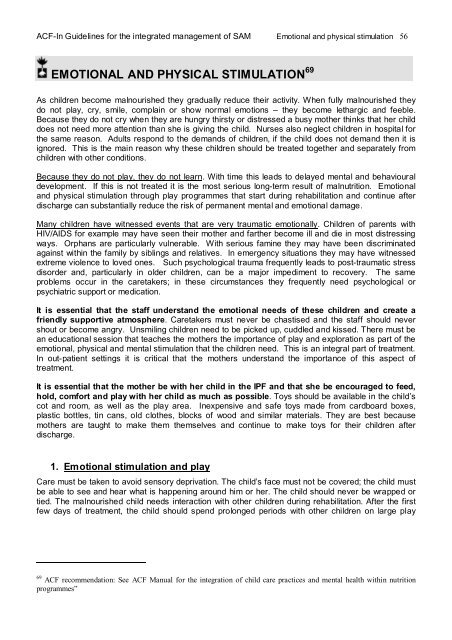guidelines for the integrated management of severe acute malnutrition
guidelines for the integrated management of severe acute malnutrition
guidelines for the integrated management of severe acute malnutrition
Create successful ePaper yourself
Turn your PDF publications into a flip-book with our unique Google optimized e-Paper software.
ACF-In Guidelines <strong>for</strong> <strong>the</strong> <strong>integrated</strong> <strong>management</strong> <strong>of</strong> SAM Emotional and physical stimulation 56<br />
EMOTIONAL AND PHYSICAL STIMULATION 69<br />
As children become malnourished <strong>the</strong>y gradually reduce <strong>the</strong>ir activity. When fully malnourished <strong>the</strong>y<br />
do not play, cry, smile, complain or show normal emotions – <strong>the</strong>y become lethargic and feeble.<br />
Because <strong>the</strong>y do not cry when <strong>the</strong>y are hungry thirsty or distressed a busy mo<strong>the</strong>r thinks that her child<br />
does not need more attention than she is giving <strong>the</strong> child. Nurses also neglect children in hospital <strong>for</strong><br />
<strong>the</strong> same reason. Adults respond to <strong>the</strong> demands <strong>of</strong> children, if <strong>the</strong> child does not demand <strong>the</strong>n it is<br />
ignored. This is <strong>the</strong> main reason why <strong>the</strong>se children should be treated toge<strong>the</strong>r and separately from<br />
children with o<strong>the</strong>r conditions.<br />
Because <strong>the</strong>y do not play, <strong>the</strong>y do not learn. With time this leads to delayed mental and behavioural<br />
development. If this is not treated it is <strong>the</strong> most serious long-term result <strong>of</strong> <strong>malnutrition</strong>. Emotional<br />
and physical stimulation through play programmes that start during rehabilitation and continue after<br />
discharge can substantially reduce <strong>the</strong> risk <strong>of</strong> permanent mental and emotional damage.<br />
Many children have witnessed events that are very traumatic emotionally. Children <strong>of</strong> parents with<br />
HIV/AIDS <strong>for</strong> example may have seen <strong>the</strong>ir mo<strong>the</strong>r and far<strong>the</strong>r become ill and die in most distressing<br />
ways. Orphans are particularly vulnerable. With serious famine <strong>the</strong>y may have been discriminated<br />
against within <strong>the</strong> family by siblings and relatives. In emergency situations <strong>the</strong>y may have witnessed<br />
extreme violence to loved ones. Such psychological trauma frequently leads to post-traumatic stress<br />
disorder and, particularly in older children, can be a major impediment to recovery. The same<br />
problems occur in <strong>the</strong> caretakers; in <strong>the</strong>se circumstances <strong>the</strong>y frequently need psychological or<br />
psychiatric support or medication.<br />
It is essential that <strong>the</strong> staff understand <strong>the</strong> emotional needs <strong>of</strong> <strong>the</strong>se children and create a<br />
friendly supportive atmosphere. Caretakers must never be chastised and <strong>the</strong> staff should never<br />
shout or become angry. Unsmiling children need to be picked up, cuddled and kissed. There must be<br />
an educational session that teaches <strong>the</strong> mo<strong>the</strong>rs <strong>the</strong> importance <strong>of</strong> play and exploration as part <strong>of</strong> <strong>the</strong><br />
emotional, physical and mental stimulation that <strong>the</strong> children need. This is an integral part <strong>of</strong> treatment.<br />
In out-patient settings it is critical that <strong>the</strong> mo<strong>the</strong>rs understand <strong>the</strong> importance <strong>of</strong> this aspect <strong>of</strong><br />
treatment.<br />
It is essential that <strong>the</strong> mo<strong>the</strong>r be with her child in <strong>the</strong> IPF and that she be encouraged to feed,<br />
hold, com<strong>for</strong>t and play with her child as much as possible. Toys should be available in <strong>the</strong> child’s<br />
cot and room, as well as <strong>the</strong> play area. Inexpensive and safe toys made from cardboard boxes,<br />
plastic bottles, tin cans, old clo<strong>the</strong>s, blocks <strong>of</strong> wood and similar materials. They are best because<br />
mo<strong>the</strong>rs are taught to make <strong>the</strong>m <strong>the</strong>mselves and continue to make toys <strong>for</strong> <strong>the</strong>ir children after<br />
discharge.<br />
1. Emotional stimulation and play<br />
Care must be taken to avoid sensory deprivation. The child’s face must not be covered; <strong>the</strong> child must<br />
be able to see and hear what is happening around him or her. The child should never be wrapped or<br />
tied. The malnourished child needs interaction with o<strong>the</strong>r children during rehabilitation. After <strong>the</strong> first<br />
few days <strong>of</strong> treatment, <strong>the</strong> child should spend prolonged periods with o<strong>the</strong>r children on large play<br />
69 ACF recommendation: See ACF Manual <strong>for</strong> <strong>the</strong> integration <strong>of</strong> child care practices and mental health within nutrition<br />
programmes”

















